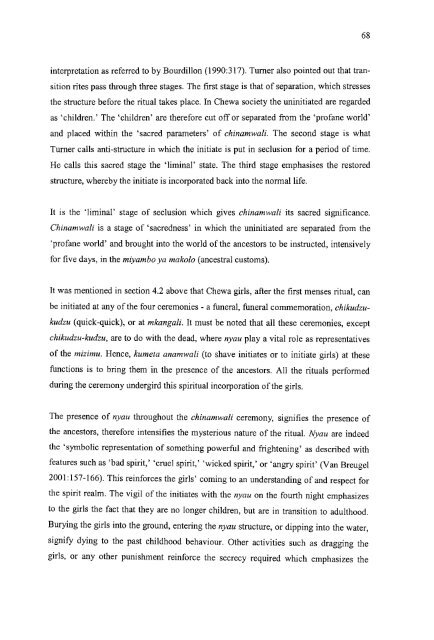FROM CHINAMWALI TO CHILANGIZO:
FROM CHINAMWALI TO CHILANGIZO:
FROM CHINAMWALI TO CHILANGIZO:
You also want an ePaper? Increase the reach of your titles
YUMPU automatically turns print PDFs into web optimized ePapers that Google loves.
interpretation as referred to by Bourdillon (1990:317). Turner also pointed out that tran<br />
sition rites pass through three stages. The first stage is that of separation, which stresses<br />
the structure before the ritual takes place. In Chewa society the uninitiated are regarded<br />
as 'children.' The 'children' are therefore cut off or separated from the 'profane world'<br />
and placed within the 'sacred parameters' of chinamwali. The second stage is what<br />
Turner calls anti-structure in which the initiate is put in seclusion for a period of time.<br />
He calls this sacred stage the 'liminal' state. The third stage emphasises the restored<br />
structure, whereby the initiate is incorporated back into the normal life.<br />
It is the 'liminal' stage of seclusion which gives chinamwali its sacred significance.<br />
Chinamwali is a stage of 'sacredness' in which the uninitiated are separated from the<br />
'profane world' and brought into the world ofthe ancestors to be instructed, intensively<br />
for five days, in the miyambo ya makolo (ancestral customs).<br />
It was mentioned in section 4.2 above that Chewa girls, after the first menses ritual, can<br />
be initiated at any ofthe four ceremonies - a funeral, funeral commemoration, chikudzu<br />
kudzu (quick-quick), or at mkangali. It must be noted that all these ceremonies, except<br />
chikudzu-kudzu, are to do with the dead, where nyau play a vital role as representatives<br />
of the mizimu. Hence, kumeta anamwali (to shave initiates or to initiate girls) at these<br />
functions is to bring them in the presence of the ancestors. All the rituals performed<br />
during the ceremony undergird this spiritual incorporation ofthe girls.<br />
The presence of nyau throughout the chinamwali ceremony, signifies the presence of<br />
the ancestors, therefore intensifies the mysterious nature of the ritual. Nyau are indeed<br />
the 'symbolic representation of something powerful and frightening' as described with<br />
features such as 'bad spirit,' 'cruel spirit,' 'wicked spirit,' or 'angry spirit' (Van Breugel<br />
2001: 157-166). This reinforces the girls' coming to an understanding of and respect for<br />
the spirit realm. The vigil of the initiates with the nyau on the fourth night emphasizes<br />
to the girls the fact that they are no longer children, but are in transition to adulthood.<br />
Burying the girls into the ground, entering the nyau structure, or dipping into the water,<br />
signify dying to the past childhood behaviour. Other activities such as dragging the<br />
girls, or any other punishment reinforce the secrecy required which emphasizes the<br />
68

















